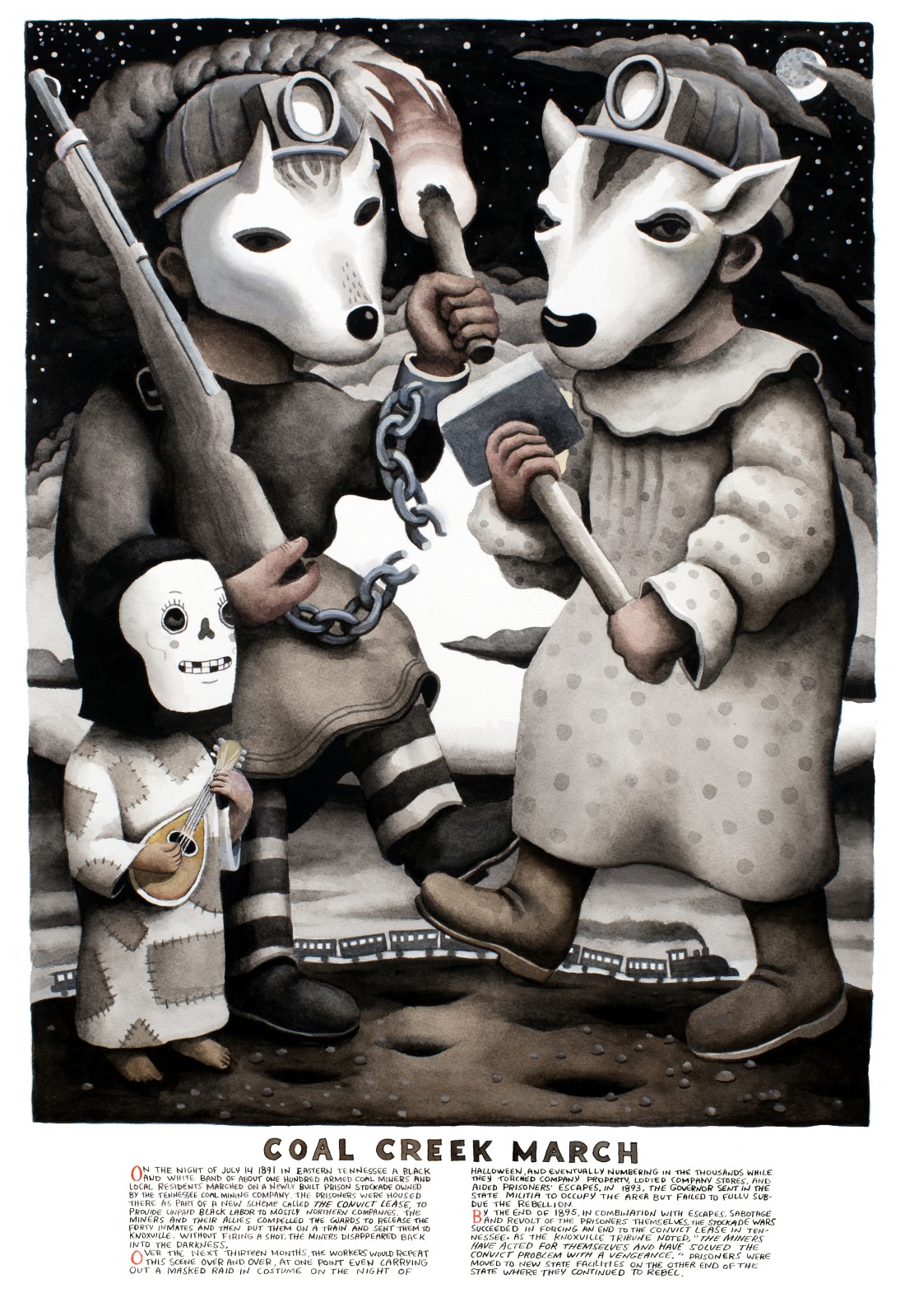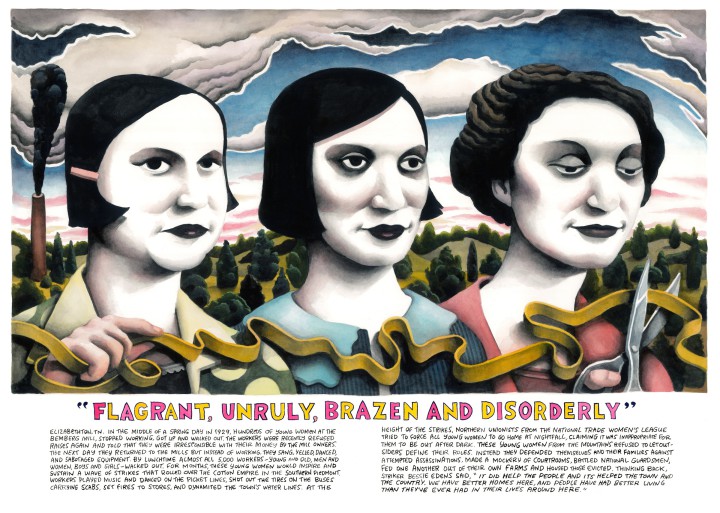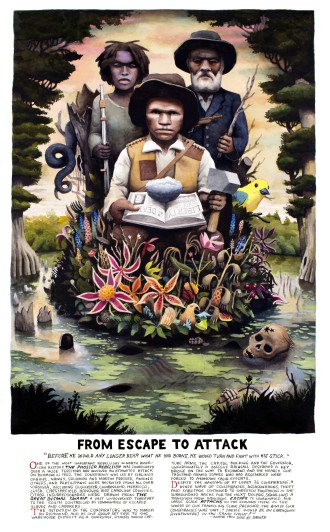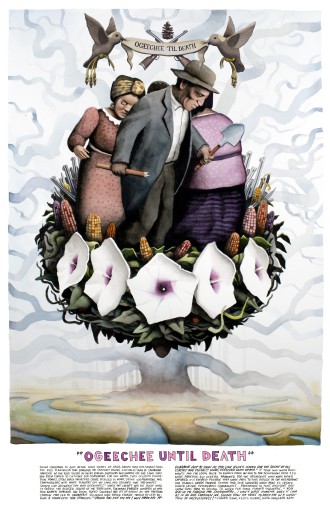The history of labor relations and social equity in the South is often seen through the haze of Confederate-revisionists, plantation horror stories and concrete, immobile social structures.
Less well-known are the numerous instances in which underprivileged Southerners took a stand against the powers that be to defend themselves against the institutional inequities of slavery, industrialization and the prison system.
Hillsborough-based artist Phil Blank has chosen to highlight several of these tales as part of the the upcoming “Southern Stories” exhibit opening Thursday, Oct. 29 at Blue Spiral 1 in downtown Asheville.
Inspired by Authors/activists Neal Shirley and Saralee Stafford‘s book Dixie Be Damned, which was published by AK Press earlier this year, Blank has created stunning visual representations of the hard-fought, often violent struggles of the disenfranchised throughout Southern history, from the coalfields of Tennessee to the anti-KKK partisan groups that roamed Robeson County, N.C., during Reconstruction.
Xpress reached out to the authors and illustrator to find out more about their inspirations and what modern-day Southerners can glean from these tales.
Phil Blank
Xpress: How did you first become aware of Dixie Be Damned? What caught your attention about the book?
Blank: I’m interested in the history of the South and how its culture has evolved. I originally did a painting of Henry Lowry years ago; one day after that, while browsing the Internationalist bookshop in Carrboro, I ran across a zine about Lowry and was really impressed by the scholarship and writing. I contacted the authors of the zine, and it turned out they were writing this book, Dixie Be Damned, with other episodes of insurrection. The book was amazing, and I thought illustrating them would be a good way to make the history more vivid and get this story into a wider audience.
What type of medium did you use to create the images?
I use watercolor and gouache, with ink for the lettering. This method tends to be among the most environmentally friendly options and is also able to duplicate the look of old-time lithographs and prints.
What themes became apparent as you created the illustrations?
We tend to think of older generations as being terribly serious, but in all these insurrections, there was a staggering amount of fun and humanity. I’m thinking of Lowry’s insistence on playing fiddle before negotiations or the wacky antics of the Elizabethton strikers: These folks were in life-and-death situations, and yet they were playing music, being joyous and even wonderfully silly in ways that are hard for modern folks to imagine. In almost every insurrection covered in the book, there is an insistence, even amongst desperately poor people, that life not be mere survival. I think parts of this dynamic have changed and been co-opted in complicated ways in recent history, but reading about it in the book was really moving.
What do you think contemporary Southern society can learn from Dixie Be Damned?
My hope is that people will hang these pictures on a wall and gently and steadily be reminded that some people had a very different take on the history of the South and how it could have been. These courageous people were sometimes successful in changing the dominant culture, sometimes not, but they were determined to give their own lives meaning and did so. Those same feelings and impulses still exist and demand to be reckoned within our culture and in ourselves.
Neal Shirley & Saralee Stafford
Xpress: What was the inspiration for Dixie Be Damned?
Shirley & Stafford: We researched and wrote the book over a period of about three years, whenever there was a break from the other parts of our lives. It was a labor of love, guided by our own participation in social struggles in the South. We’re not professional academics, so for us this was a long process of learning how to write and research. But we also benefit from that nonacademic position, in that it helps us to ask questions and observe tensions that sometimes get glossed over by the academy’s more institutionalized approach. We were also inspired by our own family histories — too often our ancestors painted a mythological, genteel image over the explicitly racialized violence that occurred during colonialism, slavery and Jim Crow, while burying the stories of resistance in those times.
Why did you choose to highlight the stories you did?
We wanted to highlight inspiring stories of resistance and revolt that we had heard little-to-nothing of, while also challenging the idea that a demand for participation in democracy via citizenship is the primary avenue for social change. An example of that is our focus on two different struggles that take place immediately after the Civil War: one led by an all-black grouping of former slaves in the Georgia lowcountry, another by a cross-racial bandit gang in Robeson County, N.C. In both situations, people who had been dispossessed and oppressed by the plantation economy led attacks on that system while simultaneously rejecting the legal processes, labor contracts, industrial projects and court systems being imported by Northern “liberators.”
Why is it important to highlight these stories from across history?
It’s a history of the present. We’re all living with the outcomes, the shortcomings and the repression of these uprisings. For those of us actively involved in social movements, this is absolutely apparent. The modern prison system emerges as an outgrowth of, as well as a response to, struggle against the convict lease system, which was itself a solution to the problem of figuring out how to keep controlling and exploiting black people after the Civil War. The story is similar with modern police forces, which in the South stem directly from early fugitive slave-hunting posses. Every neighborhood we live in that’s occupied by police, every friend or family member dealing with the law or courts — we’re all dealing with this, and the lower we are in society, the worse it is.
As individual participants in struggles that have tried to carry this legacy forward — and just as people living in this difficult world — the fear of repression and failure is constant. Both of us struggle at times with a deep despair around these issues. The writing of this book has been helpful; it’s inspiring to learn about the ways people before us have rejected these systems, found their courage and fought outside and beyond the bounds of law and property. We can do that again.
What do you think contemporary Southern society can learn from Dixie Be Damned?
We grew up being told that the South is a passive, conservative place, a land that time forgot, and that the only antidote to this is a certain kind of liberal, capitalist “progress”. Those are two false narratives. We actually have this incredible inspiring history of resistance in the South that rejects and challenges both those stories. This is where whiteness, as a marker and producer of political and economic domination, originates, and (not coincidentally) this region is, in some ways, the historical heart of global capitalism. But it is also a place of creative resistance and resilience against oppression. We hope to inspire others to look into Southern history outside of the academy and paid professional world, with an eye toward sharing stories of resistance and liberation.
Any upcoming promotional efforts or shows to publicize the illustrations and book?
We’re on tour right now and coming through Boone to talk at Appalachian State University on Oct. 21 and 22. After that we’re heading up the East Coast for another week of tour, then coming back home to friends and work and projects back in Durham. We’re hoping to do some joint events with Phil and his incredible artwork when we get back: one in Chapel Hill and one in Durham. In mid-November we’re participating in the Howard Zinn Bookfair in the Bay Area, and then giving a talk at the Duke Coffeehouse on Nov. 20th.
Phil Blank’s illustrations will be on display at Blue Spiral 1 in downtown Asheville Thursday, Oct. 29 through Dec 23. To purchase a copy of Dixie Be Damned, visit akpress.org.







Before you comment
The comments section is here to provide a platform for civil dialogue on the issues we face together as a local community. Xpress is committed to offering this platform for all voices, but when the tone of the discussion gets nasty or strays off topic, we believe many people choose not to participate. Xpress editors are determined to moderate comments to ensure a constructive interchange is maintained. All comments judged not to be in keeping with the spirit of civil discourse will be removed and repeat violators will be banned. See here for our terms of service. Thank you for being part of this effort to promote respectful discussion.